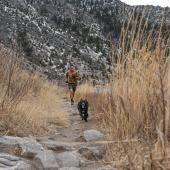Running with Wolves
In Montana, attacks on runners and hikers are rare, and most women are assaulted by men they know in places they consider safe—but statistics are no consolation. When alone on the trail, be on the defensive and increase your safety through basic risk management and knowledge of violence dynamics.
Increase Awareness to Decrease Opportunities
Nature is a valuable guide—just think of wolves, who are opportunistic. When hunting, they assess cost, benefit, and risk; human predators are similar. On the trail, you can’t control human predators, but you can de-select yourself as a target and decrease a predator’s opportunities to corner you. Your first goal should always be avoidance.
Enjoy your outing, but don’t be oblivious—practice situational awareness. Remain alert to your environment and other people, and remember that predators need physical proximity. Opt for risk reduction when hitting the trails by avoiding isolation and choosing a companion, either human or dog. If you decide to trade safety for solitude, use your senses—wear headphones only on populated trails, and be aware of ambush points, like blind corners or dense brush. Avoid predictability, and don’t run the same trail at the same time every day. Think like a predator—what ambush points would you choose, and when?
Be a Bad Target
Wolves select vulnerable, timid, weak targets by observing movement, posture, and demeanor to identify low-risk prey. According to prison interviews, many human predators hunt the same way. Cow elk display specific trotting, head, and neck positions to appear strong and deter wolves. Your alert, confident, and assertive demeanor, and even eye contact, can discourage human predators. Good posture may not only improve your running and hiking, but it can also increase your safety.
Be alert to “charm predators” or “wolves in sheep’s clothing.” Human predators have two options to lure you close enough: ambush or charm. But elk don’t fall for charm, and neither should you. Generally articulate, a charm predator may first “interview” you to determine how well you set verbal and physical boundaries. The interview may occur off the trail, at Music on Main or in a downtown bar. Besides boundary testing, the interview seeks to extract information, like routines. Predators often try to build trust and pseudo-familiarity to facilitate distracting, isolating, and ambushing their targets. Watch for these tactics.
Use Common Sense and Gut Reactions
Charm predators may approach you on the trail and ask for directions or help, preying on your social conditioning to be obliging and polite. Use common sense and instincts—elk don’t stick around wolves to be polite. If you feel uncomfortable, remember, you don’t owe strangers any answers or explanations; if you must, communicate that you’re there for exercise and need to get on with it.
Notice “trouble patterns”—unusual, unnecessary, or potentially threatening behavior. For example, if you’re running down a logging road and a truck passes you, turns, and stops beside you, be on guard and trust your gut reactions. Your limbic brain instantly assesses threats by absorbing as much as eleven million pieces of information simultaneously. You may not be able to articulate why you suddenly feel afraid or uncomfortable, but remain flexible. Change your course, turn around, or get back into your car if that’s what your instincts tell you. Intuition may save your life.
Stay Relaxed and Be Prepared
Avoid constant, low-grade paranoia—it causes ulcers. Instead, use common sense and vigilance. Stay relaxed by breathing slowly to improve general awareness, reaction time, and decision-making in stressful situations.
Your second goal should always be escape. If your avoidance strategies fail, basic self-defense skills can increase your survival chances. You’ll need to focus, snap out of your freeze, and decide what the attacker wants. Don’t risk injury to protect your possessions, but if you sense that he wants you, and you decide to fight, commit 100%. Overcoming the shock, panic, and possible injuries of a sudden attack is challenging, but an immediate, decisive counter-attack to vulnerable targets like eyes, throat, or knees, paired with yelling, may save your life. Use your hammer-fists, palm-heels, elbows, or knees, or weapons of opportunity, like a handful of dirt, rocks, or your water bottle. Train in self-defense and stay fit, and your natural weapons can become very effective.
Keep running and hiking in the Montana mountains—it’s good for you! And all things considered, the risk is fairly low, as many more women die from heart attacks than from stranger violence. Just be aware, trust your instincts, and, if necessary, counter-attack like a wolverine—ferocious and determined to win.
Briggitte Tuller teaches personal safety, self-defense, and Tawkwon-do at Three Rivers Defense (3riversdefense.com) in Three Forks.












